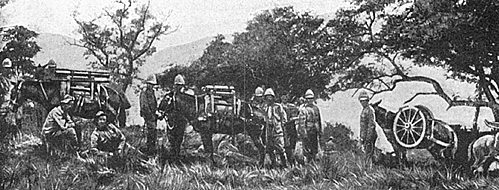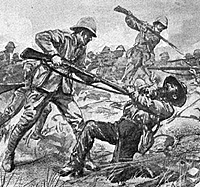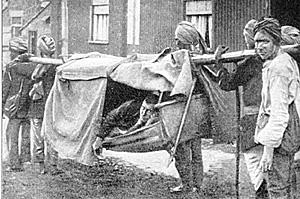INTRODUCTION
The British Empire was much the largest that the globe has ever known, over one quarter of the worlds land mass & one third of the earth's population once owed allegiance to Great Britain's flag & sovereign. This mighty empire was fed with goods from British factories, held together by the worlds largest merchant marine, its sealanes protected by the worlds largest and most powerful fleet. On land, the empire was protected and policed by a relatively small professional army provided by the mother country, backed by another professional army raised in India and by various local forces.
The general success of the British Army in its many and varied colonial wars owed much to the outstanding discipline, courage and adaptability of the troops. However, very often, the single most important factor in the success of Imperial troops was the weapons they were armed with. The nineteenth century, especially the second half of the century, was marked by outstanding progress in most fields of technology. In no area was this progress more marked than in the field of weapons, both small and artillery. In less than forty years the infantry weapon advanced from the smooth-bore musket to the magazine rifle, while guns changed from smooth-bore muzzle loaders to quick firing rifled breeched-loaders. The machine gun was also developed.
In this short article I would like to provide reader with an overview of nineteenth century weapons, as used by the British and Indian Armies, including details of the more important weapons types. Please not that ranges given are effective battlefield ranges, rather than those possible under ideal and unrealistic test conditions.
SMALL ARMS
When the young Queen Victoria came to the throne in 1837 the British Army was still, for the most part, armed with the muzzle loading smooth-bore musket popularly known as 'Brown Bess'. This was the same flintlock weapon that had defeated Napoleon's troops time after time in the Penisular and at Waterloo over twenty years before, in essences it was much the same as the weapon used by the Duke of Marlborough's troops in the early 1700's. Used en mass the 'Brown Bess' was more or less accurate up to 100 yards or so and could be fired by well trained troops perhaps three times per minute The flintlock was not overly reliable, misfires being common. The weapon was also vulnerable to heavy rain, when it might well not fire.
In 1838 British Army muskets were converted to the percussion system, percussion caps replacing the flints of the older system. This change made the weapons much more reliable and probably also led to a slight improvement in accuracy, due to the shorter delay between the soldier pulling his trigger and the weapon going off. In due course the muskets of the H.E.I.C. Army in India were also converted. British soldiers continued to use this weapon until roughly 1855 (one division were still so armed when they set out for the Crimean War in 1854). Indian troops continued to use the weapon until 1857 and after.
It was in 1853 that the British Army adopted the first rifled weapon as a general issue to all infantry. This was the Minie rifle musket, the invention of a French officer. This muzzle loading weapon was accurate to over 300 yards and was a quick to load & fire as the muskets it replaced. The Minie was used with great success in the early battles of the Crimean War, but was soon replaced by a superior British weapon, of generally similar type, the Enfield rifle- musket.
The Enfield was an excellent small arm for its day, accurate up to 400 yards or more. The rifle saw extensive service in the later stages of the Crimean War, in China, in New Zealand and India (where of the Bengal Army mutiny in 1857). The Enfield also proved very popular with both sides during the American Civil War, where it was one of the most common small arms used.
While the Enfield was a fine, high quality, fire arm, it was still a muzzle loader at a time when other countries, such as Prussia, had already adopted, or were thinking of adopting a breech loader. Britain began to look at and test breech loaders in 1864 and in 1867, began to issue a 'new' rifle. The new weapon was the Snider-Enfield single shot breech loader. This weapon was a breech loading conversion of existing Enfields. This rifle proved a great success, the conversions having slightly improved range and accuracy over the un-converted weapons. Snider- Enfields were used with success in Abyssinia in 1868 and later during the Ashanti War in West Africa. Indian soldiers were issued the Snider-Enfield between about 1872 and 1889 and used this weapon in Afghanistan, on the N.W. Frontier, in Egypt and in the Sudan.
The Snider-Enfield was never more that a 'stopgap' weapon and in 1872 British infantry began to have issued to them the finest service rifle of the day; the Martini-Henry, a single shot breech loading rifle. The Martini-Henry was accurate out to about 800 yards or so and could be fired at a maximum rate of twelve aimed shots per minute. British troops used Martini-Henry rifles in the Cape, during the 1879 Anglo Zulu War, in Afghanistan, during the First AngloBoer War of 1880-81, in Egypt and in the Sudan, among other places. It was a first class rifle of its type. Indian troops were issued the MartiniHenry between about 1889 and 1902. Egyptian troops also used the rifle durin$ the later 1880's and 1890's in the Sudan campaigns.
In 1888 the Martini-Henry began to be replaced in the British Army by the Lee-Metford, a magazine rifle sighted to over 2,500 yards, although maximum effective range was more like 1,000 yards. This weapon had a ten round magazine. It was used on the N.W. Frontier in 1895 at Chitral and again in 1897 during the Great Frontier Rising. It also saw service in the Sudan and in China and during the early stages of the Boer War. Late in 1899 it began to be replaced by the slightly improved, but generally very similar, Lee-Enfield, which saw much service against the Boers in 1899-1902.
 How the Mountain Battery is carried: One mule is laden with the 'Chase' of the gun itself, another with the breech, and two more with the wheels and the trail.
How the Mountain Battery is carried: One mule is laden with the 'Chase' of the gun itself, another with the breech, and two more with the wheels and the trail.
This latter weapon was the forerunner of the famous S.M.L.E. of 1907 that formed the basis of the standard British & Commonwealth rifle of the two Worlds Wars and on into the 1950's. Lee Metfords and Lee-Enfields were not issued to Indian troops until after the Victorian era. Both the Lee-Metford and the Lee-Enfield could fire over twenty shots per minute, in trained hands.
At various times British service rifles were used against British and Indian troops. Such weapons were sometimes sold in various parts of the world after being replaced in British service. Other weapons were stole, or captured, examples used against their former owners, while, in Afghanistan and on the N.W. Frontier of India, tribesmen often used fine local copies made in tribal workshops.
Old Tower Muskets ('Brown Bess') of flintlock or, less commonly, percussion firing, were commonly met with in tribal hands as were a variety of muzzle loading smooth-bores and shotguns while rifle-muskets were rather less common. At Isandlwana (and also at Intombi and Hlobane) the Zulu captured large numbers of Martini-Henry rifles and carbines, probably over 1,200 to add to the 10- 15,000 fire arms they already possessed. The Dervish Ansar of the Sudan captured fair numbers of Martini- Henrys and some Snider-Enfields to add to their store captured Remingtons. On the N. W. Frontier, by 1895 Snider-Enfields were not uncommon and some Martini-Henrys were met with, while by 1897 Martini- Henrys were common enough in tribal hands, as were a few Lee-Metfords.
By the later stages of the Anglo-Boer War most of the Commando's had laid aside their Mauser rifles (for which they could no longer obtain cartridges) in favour of Lee-Enfields captured from the British and Empire troops.
All of the rifles listed above were also issued in carbine form. Carbines were shorter versions issued to cavalry (but not Mounted Infantry, who used infantry rifles) and some, artillery troops, etc. In general carbines did not take bayonets and had ranges that were, for the most part, about one third shorter than the full rifle version. Because of their lighter weight and shorter length, carbines also tended to be somewhat less accurate than the longer rifles.
The machine gun was a nineteenth century invention that only reached full battlefield maturity in the early twentieth century, notably in the Great War of 1914-18. The first practical 'machine guns' were in fact hand-cranked weapons, such as the Gatling Gun, invented in the 1860's and the contemporary French Mitrailleuse used in the Franco-Prussian Ware of 1870.
In Britain it was the Royal Navy who first issued early hand-cranked machine guns such as the Gatling, Gardiner and Nordenfeld- to their ships. Such machine guns were often take ashore by naval landing parties, such as those used by the Naval Brigades in Zululand in 1879, in Egypt in 1882 and during the early Sudan campaigns, as well as in West Africa, Etc.
Gatling Guns were first used by the British Army in action in 1879 Anglo Zulu War, where they equipped a Royal Artillery battery. A few were also used, less effectively than in Zululand, in Afghanistan. Gatling guns also saw service in the Sudan and elsewhere. The Gatling had an effective range of about 1,000 yards, but did sometimes jam (tell me about it Ed).
The first effective true machine gun was the Maxim Gun, invented in 1884 and adopted by the British Army in the late 1880's. This weapon (unlike the Gatling, which was issued to artillery units) was issued to the infantry, and later the cavalry. At first one gun was issued to each unit, later two Vickers- Maxim guns were issued to each unit. Early maxims were sighted to between 1,500-3,000 yards, although effective range was more like 1,200 yards. Maxims were highly effective against 'mass charge' enemies such as Dervish Ansar and Matabele, although they proved less effective against Pathans on the N.W. Frontier, and much less effective against the wily, and generally dug-in, Boers.
Early Maxims and Vickers-Maxims were mounted on rather high tripods for infantry use and on small wheeled carriages for cavalry use. Water jackets etc, were brass and in later campaigns were often painted khaki.
ARTILLERY
Up until the Crimean War of 1854-56 and the Indian Mutiny of 1857, artillery remained essentially the same as that used throughout the eighteenth and early nineteenth centuries: Smooth- bore muzzle loading guns, howitzers and mortars, firing solid iron round shot, shrapnel and common spherical shell and caseshot. Such guns were used in the Anglo-Sikh Wars of the 1840's and changed only in that larger guns were gradually used in the field. Field Artillery used 9pd, 12pd and sometimes 18pd guns, while the Royal Horse Artillery used 6pd and sometimes 9pd guns.
Light 6pd mountain guns were also used in areas such as Afghanistan. As with small arms, percussion firing was introduced by the early 1850's. Following the Indian Mutiny of 1857 artillery, with the exception of some light mountain batteries, was not issued to Indian troops. Smooth-bore ranges were generally between 400-8000 yards.
In 1859/60 the Royal Artillery adopted 6pd and 12pd breech loading rifled guns and these were used in China and also in New Zealand. The Royal Navy also largely adopted rifled breech loading guns in this period, both as the main armament of large warships and as boat and landing party weapons. However the Navy had some problems with breech loading guns bursting on firing and subsequently adopted rifled muzzle loaders (although retaining some breech loading guns for landing party use). This move led to Army test and in 1871, rifled muzzle loading guns were adopted by the British Army in place of its rifled breech loaders. The new rifled muzzle loaders had only a very slightly shorter range that the early breech loaders were similar and safer, and could be fired just as quickly.
From 1871 until 1883 the Royal Artillery both field and horse batteries used the 9pd rifled muzzle loader. This weapon had a range of over 3,000 yards with shell. From 1865 the mountain batteries used a 7pd rifled muzzle loader which in one form or another, continued in use until the turn of the century. Mountain guns could be broken down into mule loads, although the 7pd was also sometimes mounted on a normal carriage (especially in Southern Africa). Range was just under 3,000 yards with shell. Both the 7pd and the 9pd could fire case out to about 300 yards or so.
In 1883 a 12pd rifled breech loader was adopted for both the field and horse artillery of the British Army. In 1894 a new, lighter, version of the 12pd was introduced for the Royal Horse Artillery (although R14A batteries in India also seem to have used the 15pd). This weapon continued in use until after the Anglo-Boer War and had a maximum range of over 4,000 yards (increased late in the Boer War to well over 5,000 yards).
The 12pd proved too light for the field artillery, especially when used against earthworks so, in 1895, a 15pd rifled breech loader was adopted for RFA use. Again this weapon was used until after the Anglo-Boer War, having a range of about 4,500 yards (increased late in the Boer War to almost 6,000 yards). Both the 12pd and the 15pd rifled breech loaders could fire case out to about 350 yards in emergency.
Howitzer batteries forming part of the Royal Field Artillery were formed in 1896, equipped with 5in breech loading howitzers for high angle fire. These weapons fired a 501b shell out to about 4,500 yards and were first used in the Sudan in 1898 and later in South Africa in 18991902.
The 2.5in 'Screw Gun', used from mid-1879 onwards by the mountain batteries of the Royal Garrison Artillery, and by certain Indian and other colonial batteries, was another form of 7pd rifled muzzle loader, with a range of about 3,500 yards. Just prior to the First World War the 2.5in 'Screw Gun' was finally replaced by a light mountain howitzer.
COLD STEEL
 Brown Bess, the Minie, Enfield and Snider-Enfield
were all fitted for an 18in triangular section bayonet
(although rifle regiments used a sword bayonet).
The Martini-Henry used a 21in triangular section
bayonet (although again rifle regiments and some
sergeants used sword bayonets). The Lee-Metford
and Lee-Enfield used a 12in sword bayonet.
Infantry officers normally continued to carry
swords and revolvers.
Brown Bess, the Minie, Enfield and Snider-Enfield
were all fitted for an 18in triangular section bayonet
(although rifle regiments used a sword bayonet).
The Martini-Henry used a 21in triangular section
bayonet (although again rifle regiments and some
sergeants used sword bayonets). The Lee-Metford
and Lee-Enfield used a 12in sword bayonet.
Infantry officers normally continued to carry
swords and revolvers.
British cavalry carried swords and carbines (swords and revolvers in the case of officers). Lancers carried both sword and lance.
RANGES
Ranges given are effective battlefield ranges, rather than maximum possible theoretical test ranges under ideal conditions. Dates given are those for the service life of the weapon with the regular British Army, while in brackets () give the years the weapons were used by the Indian Army.
Weaponry and Ranges
Brown Bess 1837-57 (1837-1872) 3 rpm. up to 100 yards.
Minie 1853-55(-) 3 rpm. up to 300 yards.
Enfield 1855-67(-) 3 rpm. up to 400 yards.
Snider Enfield 1867-72 (1872-89) 10 r.p.m. to 600 yards.
Martini-Henry 1872-88 (1889-1902) 12 rpm. up to 800 yards.
Lee Metford 1888-1899 (-) 20 rpm. up to 1,000 yards.
Lee-Enfield 1899-1902 (-) 20 rpm up to 1,000 yards.
Gatling Gun 1878-1889 up to 1,000 yards.
Maxim Gun 1889-1902 up to 1, 200 yards.
9pd smooth-bore muzzle loader 1837-58 up to 600 yards.
12pd smooth-bore muzzle loader 1837-58 up to 800 yards.
12pd rifled breech loader 1859-71 up to 4,000 yards.
9pd rifled muzzle loader 1871-83 up to 3,200 yards.
7pd rifled muzzle loader 1865-73 up to 2,800 yards.
2.5in rifled muzzle loader 1873-1902 up to 3,500 yards.
12pd rifled breech loader 1883 -1902 up to 4,100 yards.
15pd rifled breech loader 1895-1902 up to 4,500 yards.
5in breech loading howitzer 1896-1902 up to 4,500 yards.
 Please note that dates 'in service' are only given between 1837 and the end of the Anglo
Boer War in 1902. (Rounds Per Minute = r.p.m.)
Please note that dates 'in service' are only given between 1837 and the end of the Anglo
Boer War in 1902. (Rounds Per Minute = r.p.m.) Back to Colonial Conquest Issue 3 Table of Contents
Back to Colonial Conquest List of Issues
Back to MagWeb Master List of Magazines
© Copyright 1993 by Partizan Press.
This article appears in MagWeb (Magazine Web) on the Internet World Wide Web.
Other military history articles and gaming articles are available at http://www.magweb.com